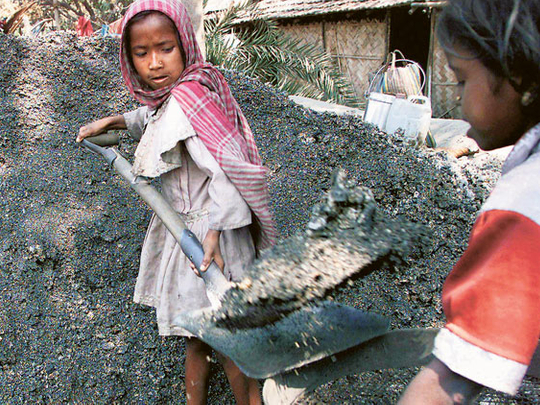
New Delhi: The signal turns red and vehicles come to a halt. It's time for Raju and Munni to hard sell bundles of incense sticks. Standing in the sweltering heat, they knock on the rolled up windows of cars to draw the attention of people inside.
"Please buy two packets, I will give one packet free," Raju cajoles a driver. He gets no response. Munni approaches another car and requests a young woman with the same plea, adding, "Memsahib, I have not had anything to eat since morning."
The woman glances towards the child. She takes out a Rs20 (Dh1.4) note and gives it to Munni. Not keen on buying incense sticks, the woman rolls up the window. The light turns green and the car speeds away.
Raju and Munni run and take shelter under a tree. They have a couple of minutes before going back to the intersection with the same appeal.
The story remains unchanged throughout the day. While some wave their hand to say no to the children, others smirk. The rest are either too busy on their mobile phones or conversing with each other to pay any attention to the children.
Acknowledging the fact that Raju and Munni are there every day, even the traffic police personnel are least bothered. This is the capital of the country and the corridor of power, where the government has crafted laws to curb child labour.
Incidentally, India has the largest number of ‘working' children than any other country in the world. Under the Child Labour (Prohibition and Regulation) Act, 1986, there is a ban on employment of children below the age of 14 years.
The Act defines a child labourer as someone who is made to work (paid or unpaid) within or outside the family and is deprived of the right to education and childhood.
In 2007, the Supreme Court issued notices to the Federal Government, states and union territories, seeking a complete ban on child labour, which included children working as domestic servants, at eateries, restaurants, hotels, tea-shops, or in recreational centres.
The Ministry of Labour and Employment notified the ban on August 1 and it came into effect on October 10. The new provision in the Act made it mandatory for the government to rescue children from streets, restaurants and homes and produce them before the Child Welfare Committee before they are sent to shelter homes.
Rama Shankar Chaurasia, chairman of the NGO, Bachpan Bachao Andolan (BBA), said: "The Ministry had asked the state governments to initiate a coordinated effort to rescue and rehabilitate children. The offenders were to be penalised under the Child Labour Protection Act and face between three months and a year in prison or a fine of up to Rs20,000 or both.
Poor track record
"But merely passing laws is not the solution. The problem lies in the implementation of these laws and the country has a poor track record in this regard. It is up to the people to consciously take a decision to stop this practice. Else, the mission will fail."
According to estimates by child labour activists, there are at present roughly 500,000 child labourers in Delhi. Of these, around 100,000 are domestic servants and rag pickers. A lot many are engaged in making plastic toys, leather shoes and hand bags.
At the age of 11, when parents pamper girls of her age, Anu faced beatings. When she could not bear the torture any more, the young girl ran away from the house of her employer in west Delhi.
The sordid reality of child labour in the city hits you in the face on hearing Anu's tale. "I was studying in Class 5 in a village in Kolkata. Poverty drove my father to send me to Delhi with an uncle. He took me to a place where I found many children like me. I was told to do embroidery on clothes."
Having an eyesight problem, Anu was never able to do a neat job. "I used to get a headache and on refusing to work would get beaten up," she said.
Her uncle then approached a placement agency and Anu was sent to a family to work as a domestic servant. She was made to cook, wash dishes and clean the house. Often beaten and kicked by her employer, one day she ran away from the house.
Anu was rescued by the BBA volunteers. She is now enrolled in a government school. But not all are as lucky.
"It is disheartening to see thousands of children in the capital who want to study, but have been compelled by their families' poor economic conditions to seek jobs and contribute to the family income," Chaurasia said.
"Ignorance, illiteracy and acute poverty are the causes for child labour. In many cases parents sell their children for a petty sum of money and end up making them bonded labours. These children, in turn, end up becoming criminals," he added.












